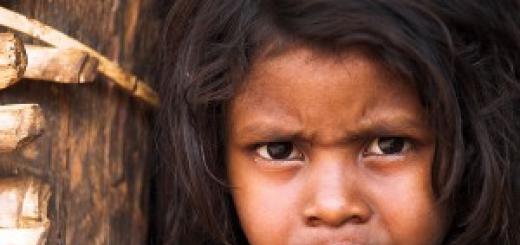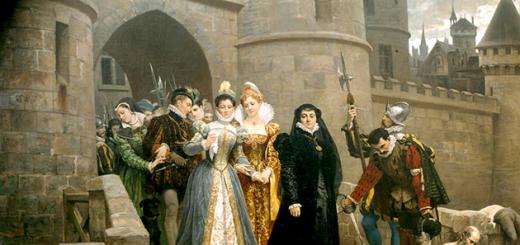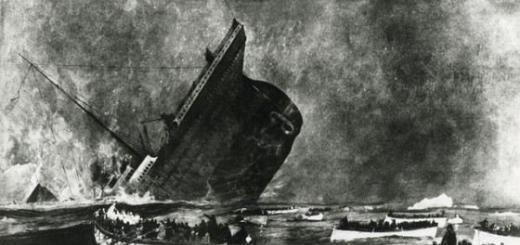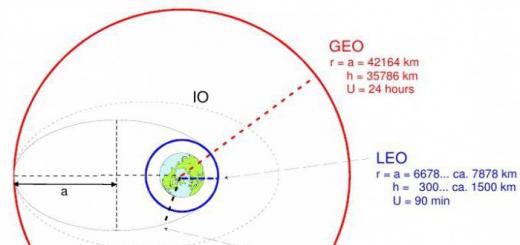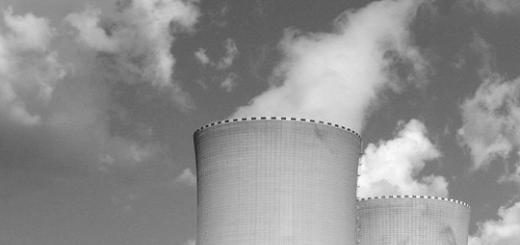Completion of the unification of Russian lands around Moscow at the end of XV- early XVI centuries Formation of the Russian state.
The process of completing the formation of the Russian state chronologically coincides with the formation of Western European countries and falls on the reign of Ivan III (1462-1505) and Vasily III (1505-1533).
After the death of Vasily II the Dark, the throne of Moscow was taken by his eldest son Ivan Vasilyevich, who became co-ruler of his father during his lifetime. It was on the lot of Ivan III that the completion of the two-century process of unification of Russian lands and the overthrow of the Golden Horde yoke fell. Distinguished by his great mind and willpower, this great Moscow sovereign:
Finished collecting lands under the rule of Moscow; laid the foundations of Russian autocracy;
Strengthened the state apparatus; raised the international prestige of Moscow.
Ivan III was the actual creator of the Muscovite state. During the years of his reign, the Grand Duchy of Yaroslavl (1463), the Perm Territory (1472), the Grand Duchy of Rostov (1474), Novgorod and its possessions (1478), the Grand Duchy of Tver (1485), the Vyatka Land (1489) were annexed to Moscow. The great and specific princes renounced the supreme rights in their possessions and passed under the political patronage of the Moscow prince.
As an independent sovereign, Ivan III began to behave towards the Tatars. In 1476, he refused to pay them an annual tribute and entered into an alliance with the Crimean Khan, an opponent of the Golden Horde. "Standing on the Ugra" (1480) put an end to the Mongol-Tatar yoke. Russian state acquired formal sovereignty.
In 1472, Ivan III married the niece of the last Byzantine emperor, Zoya (Sophia) Palaiologos, who raised the importance of monarchical power in Russia. At the Moscow court, a magnificent, strict and complex ceremonial was started according to the Byzantine model. From the end of the XV century. The seals of Ivan III depicted not only the Moscow coat of arms with George the Victorious, but also the coat of arms of Byzantium with a double-headed eagle.
The change in the socio-political status of the Grand Duke of Moscow was also reflected in his titles, now he was called: “John, by the grace of God Sovereign of All Russia and Grand Duke of Vladimir and Moscow and Novgorod and Pskov and Tver and others. In international relations, Ivan III began to call himself tsar, as before only the Byzantine emperor and the Tatar khan were called.
In 1493, Ivan III formally assumed the title of "sovereign of all Russia." The titles adopted by Ivan III - "tsar" and "autocrat" - emphasized the independence, independence of the sovereign of all Russia.
Finally, at the end of the 15th century, the existence of the Moscow state (Muscovy) became known in the countries of Western Europe. Under Ivan III, diplomatic relations were established with Germany, Venice, Denmark, Hungary and Turkey.
The son of Ivan III Vasily III, having annexed Pskov to Moscow (1510), the Grand Duchy
Ryazan (1517), the principalities of Starodub and Novgorod-Severskoe (1517-1523) and Smolensk (1514), actually completed the unification of Great Russia and turned Muscovy into the nation state.
The princes in the annexed lands became the boyars of the Moscow sovereign. These principalities were now called uyezds and were ruled by governors from Moscow. The governors were also called "boyars-feeders", since they received food for managing the districts - part of the tax, the amount of which was determined by the previous payment for service in the troops. Localism is the right to occupy a particular position in the state, depending on the nobility and official position of the ancestors, their merits to the Grand Duke of Moscow. Fragmentation gradually gave way to centralization. The administration began to take shape.
The Boyar Duma consisted of 5-12 boyars and no more than 12 okolnichi (boyars and okolnichi - the two highest ranks in the state). The Boyar Duma had advisory functions on the "affairs of the land."
The future order system grew out of two nationwide departments: the Palace and the Treasury. The palace controlled the lands of the Grand Duke, the Treasury was in charge of finances, the state seal, and archives.
In 1497, a new set of laws of a single state was adopted - the Sudebnik of Ivan III. Sudebnik included 68 articles and reflected the strengthening of the role central government in the state structure and legal proceedings of the country. Article 57 limited the right of the peasant transition from one feudal lord to another for a certain period for the whole country: a week before and a week after the autumn St. George's Day (November 26). For leaving, the peasant had to pay "old" - a fee for the years lived in the old place. The restriction of the peasant transition was the first step towards the establishment of serfdom in the country. However, until the end of the XVI century. peasants retained the right to transfer from one landowner to another.
In general, unlike the advanced countries of Western Europe, the formation of a single state in Russia took place under the complete dominance of the traditional way of the Russian economy - on a feudal basis. This makes it possible to understand why a bourgeois, democratic, civil society began to take shape in Europe, and why Russia will be dominated for a long time: serfdom, estates, inequality of citizens before the law.
Thus, the process of unification of northeastern and northwestern Russia into one state was completed. The largest power in Europe was formed, which from the end of the 15th century. became known as Russia.
Questions for self-control:
1. What are the prerequisites for the unification of Russian lands. Compare the causes of the unification process in Russia and in the countries of Western Europe.
2. What caused the victory of Moscow in its rivalry with Tver for the great reign. Describe the activities of I. Kalita.
3. What was the significance of the victory on the Kulikovo field.
4. Expand the meaning of the expression "standing on the Ugra River." When did it take place?
5. What changes in the situation of the peasants reflected the Sudebnik of 1497
Literature:
1. Georgieva N.G. Russian culture: history and modernity: Tutorial/ N.G. Georgiev. - M., 1998.
2. Zuev M.N. History of Russia: Textbook for universities / M.N. Zuev. - M., 2005.
3. History of Russia from the 9th century to the present day. - Voronezh, 1996. Materials on the history of peasants in Russia in the 11th - 12th centuries. - L., 1958.
4. History of Russia. XX century. - M., 1997.
5. History of Russia: IX-XXI centuries. From Rurik to Putin: Textbook / Ed. ed. Ya.A. Perekhov. –M., Rostov-on-Don, 2005.
6. History of Russia: In 2 volumes / A.N. Sakharov, L.E. Morozova, M.A. Rakhmatullin. - M., 2003.
7. World and Russia: main trends in history. - Voronezh, 1999.
8. Orlov A.S. History of Russia from ancient times to the present day. Textbook / A.S. Orlov, V.A. Georgiev, N.G. Georgieva, T.A. Sivokhin. - M., 2003.
9. Ryabtsev Yu.S. History of Russian culture. Artistic life and life of the XI-XVII centuries: Textbook / Yu.S. Ryabtsev. - M., 1997.
10. Semennikova L.I. Russia in the world community of civilizations / L.I. Semennikova. - Bryansk, 1995.
11. Strukov A.V. Domestic history from ancient times to the present: Textbook / A.V. Strukov. - Voronezh, 2005.
12. Shapovalov V.M. The origins and meaning of Russian civilization: Textbook / V.M. Shapovalov. - M. 2003.
End of work -
This topic belongs to:
A course of lectures on the discipline Domestic History Lecture No. 1 Topic: Formation and development of the Old Russian state. Kievan Rus in IX-XII centuries
Voronezh Institute of High Technologies. Faculty distance learning.. A V Strukov N V Bozhko ..
If you need additional material on this topic, or you did not find what you were looking for, we recommend using the search in our database of works:
What will we do with the received material:
If this material turned out to be useful for you, you can save it to your page on social networks:
| tweet |
All topics in this section:
The problem of origin, resettlement, economic activity and social system of the Eastern Slavs
Origin problem Eastern Slavs is still debatable: there are various versions as to where the ancestral home of the Slavic peoples was located. But the basis of most theories
Formation of the Old Russian state. "Norman Theory"
The emergence of the state is a natural stage in the development of society. It is influenced by many factors that are in complex interaction with each other. We should probably not talk about isolated
Kievan Rus in the X-XII centuries
The process of formation of the Old Russian state lasted for about a century and a half. First Kiev prince Oleg (882-912), Igor (912-945), Olga (945-964), Svyatoslav (964-972), Yaropol
Culture of Ancient Russia. Significance of adopting Christianity
Conversion to Christianity is one of the most important milestones in the history of the Russian people. Traditionally in national historiography the significance of the adoption of Christianity was reduced to the development of writing and cult
Causes and nature of feudal fragmentation
According to the generally accepted point of view, from the middle of the XI - early XII centuries Old Russian state entered into new stage of its history - an era of political and feudal fragmentation. Kievskaya
Features of the political and socio-economic development of Vladimir-Suzdal and Galicia-Valyn principalities, Novgorod land
the largest government centers into which Kievan Rus, not inferior in terms of occupied territory to large European states, became Vladimir-Suzdal, Galicia-Volyn
Mongol invasion of Russia. Russia and the Horde: problems of mutual influence
Feudal fragmentation, accompanied by interprincely clashes, the ruin of cities and villages, led to the weakening of Russia. This circumstance did not fail to take advantage of foreign
Prerequisites for the unification of Russian lands
The process of formation of the Russian centralized state began in the second half of the 13th century. and ended at the beginning of the 16th century. At this time, the political independence of a number of
The main stages of the unification process
1. The end of the 13th - the 1st half of the 14th century: the strengthening of the Moscow principality and the beginning of the unification of the Russian lands, headed by Moscow. The founder of the dynasty of Moscow princes was younger son Alexandra
Russia in the middle of the XVI century
At the end of the XV - beginning of the XVI century. on the site of many independent principalities and lands, the Muscovite state was formed. There was a sharp reduction in feudal immunities, the former Grand Dukes
Reforms of Ivan the Terrible. Oprichnina: its essence, goals and results
After the death of Vasily III in 1533, his three-year-old son Ivan IV took over the throne. In fact, the state was ruled by his mother Elena, the daughter of Prince Glinsky, a native of Lithuania. In the years
Foreign policy
The main objectives of Russia's foreign policy in the XVI century. were: in the west - the struggle for access to the Baltic Sea, in the southeast and east - the struggle with the Kazan and Astrakhan khanates and the beginning of the development
Russian culture of the 16th century
Russian culture of the 16th century, although it was not alien to borrowings from the West and the East, basically developed its own traditions of the previous period. It developed mainly within the framework of the
The crisis of Russian statehood. "Time of Troubles"
In the historical literature, the events of the late 16th - early 17th centuries. commonly referred to as the Trouble. This is a period of deep socio-economic, political and spiritual crisis of Russian society. Last
Socio-economic and political development of the country under the first Romanovs
Agriculture remained the leading sector of the economy. The growth in production volumes was achieved by involving new lands in the economic turnover: the Black Earth Region, the Middle Volga Region, and Siberia.
Popular movements
The economic and political development of the country was accompanied by major social movements. XVII century not accidentally called the "rebellious age". It was during this period that two peasant "with
church schism
Changes in the socio-economic and political life of the country in the XVII century. affected the church, putting it before the need for transformation. The reform began with the correction and unification of theology
Transformations of Peter I
The general pattern of world development in the eighteenth century is the close interweaving of the characteristic features of the "old" and "new" worlds, the Middle Ages and the consequences of the English
Features of the development of Russia in the era of palace coups
In January 1725, Peter I dies. Back in 1722, he issued a decree according to which the throne was inherited by a person named in the will of the emperor. However, he did not have time to name his heir. From now on
Domestic and foreign policy of Catherine II
July 28, 1762 to the Russian throne as a result of another palace coup Catherine II ascended, ruling for 34 years. She was highly educated, intelligent, businesslike, energetic, ambitious and personable.
Alexander I: attempts to liberalize the existing regime
As a result of the coup in March 1801 on Russian throne ascended Emperor Alexander I (1801-1825) feature Alexander's reign becomes a struggle between two currents - the liberal
Domestic policy of Nicholas I
Peculiarities domestic policy Nicholas I (1825-1855) were determined, on the one hand, by the impressions of the Decembrist conspiracy, which made him think about strengthening his own power, about fighting
Ideological currents and socio-political movements of the first half of the 19th century
In the social movement of the second quarter of the XIX century. the delimitation of three ideological directions began: radical, liberal and conservative. Conservatism in Russia relied on theories that proved
Russia's foreign policy in the first half of the 19th century
The international position of Russia at the beginning of the century was very difficult. On the one hand, active actions were necessary in the struggle to strengthen positions in the Black Sea, the Balkans and the Transcaucasus, where
Bourgeois reforms of the 1860s and 70s and their meaning
On February 19, 1855, after the death of Nicholas I, Alexander II ascended the throne. His reign (1855-1881) became a period of radical transformations in Russian society, the main of which was
The industrial revolution and the formation of an industrial society in Russia
Economic and social development Russia directly depended on the conditions for the implementation of the peasant reform. From the second half of XIX in. capitalism began to establish itself as the dominant social
Policy of counter-reforms of Alexander III
Considering the government's course Alexander III(1881-1894), it should be borne in mind that he went down in history as a period of "counter-reforms". The closest circle of Alexander III were the most
Features of the social movement in the post-reform period. Populism
Second half of the 19th century in the spiritual sphere is characterized by contradictory tendencies. On the one hand, in the second half of the 50s of the XIX century. (the period of preparation of the peasant reform) in the social
Foreign policy of Russia in the second half of the 19th century
In the foreign policy of Russia in the second half of the XIX century. three main areas can be distinguished: 1) Russia's European policy: the struggle to revise the results Crimean War, strengthening the position of Ro
Russian culture of the 19th century
Home hallmark development Russian culture in the 19th century was that it developed rapidly, managed to reach the world level, and in some areas even surpassed
Socio-economic and political situation
characteristic feature early 20th century was the process of establishing monopoly capitalism. This was facilitated by the development of the productive forces of society. Achievements in the field of natural sciences
Revolution of 1905-1907: background, main stages and results
The beginning of the revolution was the events of January 9, 1905. In Petersburg. Priest G. A. Gapon, associated since 1902 with Zubatov and since 1904. head of the Assembly of factory workers of St. Petersburg,
Reforms P.A. Stolypin
The implementation of reforms is associated with the name of P.A. Stolypin, who proclaimed the principle: "first calm, and then reforms." In this spirit, the government program published on August 24
Russia's participation in the First World War
Back in 1882, the Tripartite Alliance was concluded, consisting of Germany, Austria-Hungary and Italy. He was opposed by the alliance between England, France and Russia that arose just before the start of the war, created in
February Revolution 1917
By the beginning of 1917. Russia is in a critical situation. The economy overcame the difficulties of the first months of the war and provided the armed forces with everything they needed relatively well. However, under the influence
Alternatives for the development of Russia and socio-political practice in the spring-summer of 1917
February Revolution, the overthrow of the autocracy put Russia before choosing the path of further development. The situation in the country had changed radically, but the prospects were not yet clear. In Russia there was
Political situation in autumn 1917 Bolsheviks come to power
The failure of the "Kornilovism" at the end of August 1917 opened the way for the Bolsheviks to come to power. Bolshevization of the Soviets began in places. Since September 1917, the leadership of the Soviets passed to them and their litter
Civil war in Russia: causes, course, results
The proclamation of Soviet power as a result of the October Revolution intensified open opposition in society. As early as next year, the intensity of political passions in Russia kindled ruthlessly
Transition to a new economic policy. NEP-Based Transformations
20 - 30s. XX century occupy their well-defined place in the world and national history. It was at this time that a new geopolitical and economic situation was taking shape in Europe,
Intra-party struggle during the years of the NEP
With the transition to the NEP, there is a certain liberalization of the political regime. The armed forces were significantly reduced (by 10 times), the system of coercion was weakened, there was a "revival"
Formation of the USSR
The characterization of the socio-political development of the country in the 1920s would be incomplete without an analysis of the problems of nation-state building and the country's relations with the outside world.
Socio-economic development: a course towards industrialization and collectivization
Industrialization - the creation of large-scale machine production, primarily heavy industry (energy, metallurgy, mechanical engineering, petrochemistry and other basic industries); P
The formation of a totalitarian system and the establishment of the regime of personal power of V.I. Stalin
Modern researchers assess the nature of the changes that took place in the political system of the Soviet state in the 1930s in different ways. Most call this time a victory for
The foreign policy of the Soviet state in the 1920-30s
The end of the First World War (the signing of the Versailles Peace Treaty in 1919), the Civil War and foreign intervention on the territory of Russia created new conditions in the international
Culture in the 1920s and 30s
The policy of the Soviet state in the field of culture in the 20-30s. was focused on turning the system of education, social sciences, literature, art into tools for “educating
The beginning of the war. Reasons for the failures of the Red Army
What was the policy of the Soviet Union after the start of World War II? In 1939-1940. Stalin was concerned primarily with the annexation of the territories of Eastern Europe to the USSR.
A turning point in the course of the war
In July 1942, German troops under the command of Field Marshal F. Paulus launched an attack on Stalingrad (now Volgograd), a former key point in the Volga region. August 23 fascist
The end of the Great Patriotic War and the Second World War. Results and the price of victory
In 1944 offensive operations The Red Army continued. Their peculiarity was that the offensive was carried out along the entire front, from Odessa in the south to Pechenga in the north (so
Restoration and development of the national economy
During the years of the Great Patriotic War Soviet Union suffered not only the greatest human losses, but also huge material damage, which amounted to an astronomical amount of about 3 trillion
internal political life of the country. 1945-1953
The transition to peaceful construction required the reformation of state administration. In September 1945, the State Defense Committee (GKO) was abolished, the functions of which were transferred to the Soviet
Socio-economic and political transformations of N.S. Khrushchev
In March 1953, I.V. died. Stalin. Immediately after his death, the Plenum of the Central Committee of the CPSU was held, at which positions in the management of the state and the party were distributed. Key positions in
Foreign policy of the USSR. 1945-1964
The geopolitical structure of the world as a result of the defeat of Germany and its allies acquired new centers of influence, the world became more and more bipolar. In the balance of power the main role belonged now
Reform of 1965 and socio-economic development of the country
After the removal of N.S. Khrushchev at the October (1964) Plenum of the Central Committee of the CPSU, L.I. Brezhnev was elected First Secretary of the Central Committee of the Party. At first, many of the party
Features of political and spiritual development
In 1977 a new Soviet Constitution was adopted. It was based on the concept of developed socialism. By the mid-1970s, it became clear that the building of communism outlined by the Program
Achievements and miscalculations of foreign policy
Soviet foreign policy during the period under review was quite active. Despite the unfolding arms race and increased international tension in the 70s, the Soviet
The search for ways to "improve socialism": changes in the economic, social, political spheres
After Chernenko's death, the Politburo of the Central Committee of the CPSU began a struggle for the post of head of the country. M.S. won this fight. Gorbachev, who had many years of experience in party work behind him
The policy of "new thinking" in international relations
The ideological basis on which they built international relationships The USSR during the period of perestroika became the so-called new political thinking. New policy announced by the Soviet
Exacerbation of national problems. The collapse of the USSR
One of the problems that caused the collapse of perestroika and the collapse of the USSR was the aggravation of interethnic relations, which was explained by numerous problems in national relations.
Socio-economic transformations
In 1992, economic measures were continued to transfer command and control principles of management to a market system of regulation. The core of the economic reform was the program "sho
Radical political modernization
The course towards liberalization of the economy, the ongoing economic crisis and the lack of social guarantees caused dissatisfaction and irritation among a significant part of the population. Dissatisfaction result
The main directions of foreign policy activity of modern Russia
After the collapse of the USSR, Russia's position in the international arena changed. The foreign policy concept of the Russian Federation included the following tasks:
Methodological development is a summary of the lesson to the specified topic. On the basis of knowledge about the features of the state, students prove that under Ivan III a centralized state was formed. The method of problem-based learning, the method of group work and the case method are used.
Download:
Preview:
The final stage in the creation of a unified Russian state under Ivan III and Vasily III.
The purpose of the lesson: Formation in students of a holistic view of the formation of a single state under Ivan III and Vasily III.
Tasks:
Tutorials: to ensure awareness of the goal by students, causing their personal, interested attitude towards its achievement; trace the process of completing the unification of Russian lands around Moscow; find out how the Mongol-Tatar yoke was overthrown.
Developing: develop independent thinking activity of students. Develop the ability to use the techniques of comparison, generalization, draw conclusions; ability to analyze; cartographic skills and skills of working with text and historical sources.
Educators: foster active citizenship; feeling of patriotism; maintain an interest in the past of their country.
Equipment
Handout. (Case)
multimedia projector;
Screen;
Russian history textbook
Lesson type: final lesson
Type of lesson: practical lesson , designed for 1 lesson
Technology: problem learning, case - technologies,information Technology, person-oriented approach, health-saving technologies (change of activities, non-standard lesson)
Advance task:several students receive an individual task:
prepare a message about the history of the Russian coat of arms
choose illustrations in the direction of the activities of your groups
Planned results:
In the process of mastering the topic, it is proposed to form the following competencies:
receiving and processing information; use of separate parts of tasks and linking together, the ability to work in a group.
Form of organization of student activities:individual and group
Technological map of the lesson
n No. n\n n | During the classes | Time | View activities | Note |
Organizing time | 3 min. | |||
Actualization of the lesson | 5 minutes. | teacher's word game moment | ||
Statement of the problem task | 5 minutes. | Poll on the topic signs of the state and | Teacher's comments, selection of key points and displaying them in a notebook |
|
Instruction on performing tasks in groups | 4 min. | teacher's word | ||
Group work | 5 minutes | Working with cases, solving tasks, working in groups | The class is divided into 5 groups |
|
Speakers' speech | 15 minutes (3min per group) | Discussion of the results of independent group work | selecting key points and displaying them in a table |
|
Lesson summary, final part | 8 min. | teacher's word | Summarizing the material of the lesson answering the problem |
Lesson outline
1. Organizational stage
Goal setting. (introductory speech of the teacher)- updating the topic of the lesson, its practical significance, educational and educational value, communication of the goal, lesson plan, creation of a friendly atmosphere.
Teacher: In 1487, the German knight Nikolai Poppel spoke in Nuremberg about his discovery: during a trip to northeastern Europe, he discovered a strong, independent state- Muscovy. Emperor Frederick III and the princes of the Holy Roman Empire listened to him with astonishment. Merchants and geographers knew, of course, about the existence of the Grand Duchy of Moscow. A surprise was the information about the strength of the young state, about its independence, wrested from the Tatar Khan. The surprise was pleasant for the emperor, because the Polish Jagiellons pressed on the borders of the empire, and Muscovy, according to Poppel, was a long-standing enemy of Lithuania and Poland. The knight traveler was immediately sent back to Moscow, where he appeared at the beginning of 1489 as an imperial ambassador. Frederick III proposed marriage between Ivan's daughter and the imperial nephew, Margrave Albrecht of Baden, and to annex Moscow to the Holy Roman Empire by granting the Grand Duke a royal title. The ambassador was surprised that the offer was proudly rejected. Poppel was informed on behalf of the Grand Duke that the Moscow sovereigns, “appointed from God”, never asked for “appointment” from anyone, and now they don’t need it.
So, the process of completing the formation of the Russian state falls on the reign of Ivan III (1462-1505) and Vasily III. (1505-1533). Ivan III of Moscow, the Grand Duke, is one of the greatest figures in history. For his era, he was a fearless reformer, builder of a new system of state and public relations. He created a strong army, a single set of laws for the whole country, destroyed the yoke of the Golden Horde, made Russia a full participant in European politics. Ivan III stands at the origins of two key phenomena in Russian history: autocracy and serfdom. Yes, and the very name "Russia" our country received it then
Formulation of the problem:Is it really in Russia in the XV-XVI centuries. formed a centralized state?
The class is divided into groups, briefing is carried out. At the disposal of each group: a sheet of drawing paper, felt-tip pens, glue, case materials. The task of the groups is to prove that Russia in the XV-XVI centuries. was on the way to the formation of a centralized state. Fill in the table during the lesson"The final stage in the creation of a unified Russian state"
2. Learning new material
To answer the question Is Russia really in the XV-XVI centuries. was on the way to the formation of a centralized state, it is necessary to recall
Prerequisites for the unification of a single state.
signs of a single state (presentation1)
Notebook entry:
Subject:
"The final stage in the creation of a unified Russian state under Ivan III and Vasily III."
The process of completing the formation of the Russian state falls on the reign of Ivan III (1462-1505) and Vasily III. (1505-1533).
Prerequisites for the formation of a single state in Russia in the XIV-XV centuries.
1.Economic
Establishing stability and order in the country
Favorable environment for unhindered trade.
Strengthening by boyars and nobles of possessions; preservation of the dependent peasantry.
2. Political
The presence of the autocracy of the Moscow prince;
The trend towards the elimination of independent principalities and appanages.
Strengthening the nobility by limiting the power of the old aristocracy (the interests of the service class).
3. Foreign policy (external threat)
The need for final liberation from the Mongol yoke;
The presence of a constant threat from the West and East.
4.Religious
Preservation by the Orthodox Church of the unity of the people, between different parts of the country;
Strengthening the economic and moral positions of the church.
Table "The final stage in the creation of a unified Russian state"
Signs of a centralized state | Creation of a unified Russian state |
1. territory. The state is a single territorial organization of political power throughout the country. | |
2. population. within the framework of the state, people are united and they act as an integral organism - society | |
3. public authority.The state is a special organization of political power, has a special apparatus of coercion, consisting of the army, police, gendarmerie. Through the system of its bodies and institutions, the state directly manages society. | |
4. obligatory fees from citizens - taxes, taxes, loans. | |
5. publication of legal norms. | |
6. sovereignty, state symbols |
Group work:
Task for group 1 "geographers" (1. sign of the state-territory)
Based on the proposed materials, draw up a comparative table "Territories annexed under Ivan III and Vasily III,"
Task for group 2 (3. sign of the state - army)Based on the information provided, answer the questions.
Task for group 3 (3. sign of the state - public authority, management apparatus)
Based on the proposed materials to draw up a scheme of government of the state.
Task for group 4 (5. sign of the state - the publication of legal norms.)
Task for group 5 (6. sign of the state - sovereignty, state symbols)
Based on the proposed materials, draw up a diagram of the "Main Directions of Foreign Policy"
Main Directions of Foreign Policy
Western Eastern
Message about state symbols
3. Summing up.
Russia in the XV-XVI centuries. was on the way to completing the formation of a centralized state. The undertakings of Ivan III will be continued and completed by his son Vasily III. So, the process of completing the formation of the Russian state falls on the reign of Ivan III (1462-1505) and Vasily III. (1505-1533). Ivan III of Moscow, the Grand Duke, is one of the greatest figures in history. For his era, he was a fearless reformer, builder of a new system of state and social relations. He created a strong army, a single set of laws for the whole country, destroyed the yoke of the Golden Horde, made Russia a full participant in European politics. Ivan III stands at the origins of two key phenomena in Russian history: autocracy and serfdom. Yes, and the very name "Russia" our country received it then
4. Reflection.
The lessons of history are always important for us, history is not a frozen science, it continues to teach its descendants. Why do you think the events of those distant times are important for us today?
4. Homework.
Write an essay
History test The creation of a unified Russian state and the end of the Horde rule for 6th grade students with answers. The test includes 2 options, each option consists of 2 parts (part A, part B). In part A - 5 tasks, in part B - 2 tasks.
1 option
A1. The accession of Novgorod to the Muscovite state refers to
1) 1453
2) 1478
3) 1510
4) 1521
A2. Read a passage from a historical source and indicate what event is being discussed.
“The news came to the Grand Duke that Tsar Akhmat was coming in full force, with his horde…
It was then that the most glorious miracle of the Most Pure Mother of God happened: when our people retreated from the coast, the Tatars, thinking that the Russians were giving up the coast to them in order to fight with them, frightened, fled. And ours, thinking that the Tatars had crossed the river and were following them, came to Kremenets. The great prince with his son ... went to Borovsk ... It was then that the miracle of the Most Pure One happened: some fled from the others, and no one pursued anyone ... And God and the Most Pure Russian land delivered from the infidels ... "
1) Battle of Kulikovo
2) taking Kazan
3) standing on the river Ugra
4) the battle on Kolka
A3. Under Basil III, Lithuania was conquered
1) Polotsk
2) Smolensk
3) Kyiv
4) Brest
A4. What contributed to the success of the Moscow princes in the struggle against Lithuania for the Russian lands under its rule?
1) Moscow's support from Poland
2) discontent of the population of Russian lands Principality of Lithuania adoption of Catholicism as the state religion
3) Moscow's support from the Golden Horde
4) the defeat of the Grand Duchy of Lithuania as a result of an unsuccessful war with the Teutonic Order
A5.
1) Sergius of Radonezh
2) Elena Glinskaya
3) Dmitry Bobrok-Volynsky
4) Martha Boretskaya
IN 1. Establish a correspondence between the names of the Moscow princes and the events associated with their reign: for each element of the first column, select the corresponding element from the second column.
Moscow princes
A) Vasily III
B) Ivan III
B) Dmitry Donskoy
1) annexation of Ryazan
2) annexation of Kolomna
3) Khan Tokhtamysh's raid on Moscow
4) battle on the Shelon River
IN 2. Arrange in chronological order the Horde rulers. Specify the answer as a sequence of digits of the selected items.
Option 2
A1. Which of the above was a consequence of the event that went down in history as “standing on the Ugra River”?
1) the fall of the Horde yoke
2) accession to Moscow of the Nizhny Novgorod principality
3) the ruin of the Horde army of Moscow
4) the seizure of the Moscow throne by Dmitry Shemyaka
A2. The accession of Tver to the Moscow state refers to
1) 1392
2) 1425
3) 1464
4) 1485
A3. Under what prince did the unification of Russian lands end with the annexation of the Ryazan principality?
1) Basil II
2) Ivan III
3) Ivan II
4) Basil III
A4. Which of the listed historical figures refers to the contemporaries of Ivan III?
1) Edigey
2) Khan Akhmat
3) Timur
4) Khan Tokhtamysh
A5. Read a passage from a historical source and indicate what phenomenon the events described in it are associated with.
“We don’t want for the Grand Duke of Moscow, we don’t want to be called his patrimony, we are free people, we don’t want to endure insults from Moscow, we want for the King of Poland and the Grand Duke of Lithuania Casimir,” so the boyars and their supporters shouted at the veche.
1) the fall of the Horde yoke
2) the conclusion of a union between Lithuania and Poland
3) the struggle of Novgorod for the preservation of independence
4) civil strife in the Moscow principality between the descendants of Dmitry Donskoy
IN 1. Establish a correspondence between events and their dates for each element of the first column, select the corresponding element from the second column.
A) standing on the river Ugra
B) Battle of Kulikovo
B) Battle of Grunwald
1) 1380
2) 1410
3) 1445
4) 1480
IN 2. Arrange the territories in chronological order of their accession to the Moscow Principality. Specify the answer as a sequence of digits of the selected items.
1) Novgorod the Great
2) Mozhaisk
3) Nizhny Novgorod principality
4) Tver
Answers to the test on history Creation of a unified Russian state and the end of the Horde dominion
1 option
A1-2
A2-3
A3-2
A4-2
A5-4
B1-143
B2-3142
Option 2
A1-1
A2-4
A3-4
A4-2
A5-3
B1-412
B2-2314
Having won the struggle for the great reign in Russia, the Moscow princes continued their efforts to unite the lands around Moscow. The reign of Ivan III (1462-1505) accelerated this process. In 1463, pursuing a unifying policy, he annexed the Yaroslavl principality.
The principality of Tver and Novgorod Republic. To preserve their independence, the Novgorod boyars entered into an alliance with Lithuania and ended up under the partial rule of the Lithuanian prince Casimir IV.
In 1471, Ivan III led an army to Novgorod and won a victory in the battle on the Shelon River. For the complete conquest of Novgorod, a second campaign was also needed. In 1478, Ivan III finally conquers the city (having withstood the siege) and deprives it of its independence by abolishing the organs local government and liquidation of the symbols of independence (the Veche Novgorod bell was taken to Moscow). With the fall of Novgorod, all of its vast territories fell into the possession of Moscow.
In 1472 the Perm Territory was conquered. In 1474, the Rostov Principality was redeemed. In 1485, Ivan III, at the head of a large army, approached Tver and took the city without loss in two days, taking advantage of the betrayal of the Tver boyars. Grand Duke Mikhailo Borisovich fled to Lithuania.
Having annexed Tver, Ivan III created a single state and began to title himself the sovereign of all Russia.
In the middle of the 15th century Golden Horde broke up into several independent khanates. Ivan III began to behave towards them as an independent sovereign. He stopped paying the ransom and created an alliance with the enemy of the Golden Horde - the Crimean Khan.
The Golden Horde Khan Akhmat tried to restore his power over Russia. In 1480, having entered into an alliance with the Lithuanian Grand Duke and Polish king Casimir IV, he led his troops to Moscow.
It all ended with a confrontation between the Russians and Tatar troops on the river Ugra.
Without waiting for the allies, Akhmat did not dare to start the battle and in November 1480 he was forced to retreat. This meant the final fall of the Mongol-Tatar yoke, which had weighed over Russia for more than two centuries.
Ivan III sought to further expand the state. In 1487 Kazan recognized its dependence on Moscow. By the end of the 15th century the state includes territories in the northeast. Ivan III conquers a number of Belarusian and Ukrainian lands from Lithuania and Poland.
The unifying policy was continued by the son of Ivan III - Vasily III. In 1503, having destroyed the Pskov feudal republic, he annexed Pskov. In 1514 he recaptured Smolensk from Lithuania. In 1517-1523. Vasily III took Chernigov and the principality of Ryazan.
The process of formation of a single state consisted in significant internal socio-economic and political changes. This was expressed in the formation of a regime of a class-representative monarchy, in which the autocracy is supported by various classes, primarily the nobility, the townspeople and the top of the capital's boyars, who were interested in creating a state and having a strong central authority in it.
The years of the reign of Ivan III are characterized by changes in the authorities. The Boyar Duma becomes the supreme advisory body, institutions are created that are in charge of various areas public life, the first orders are issued, the governors are engaged in local administration and are supported by the territories they control.
In 1479, the “Sudebnik” of the Grand Duke Ivan III was published - a code of laws, the first code of the Russian state, which consolidated a unified system government controlled and regulated the activities of state bodies. The Sudebnik set a deadline for peasant transitions (once a year, on St. George's Day) and payment for the use of the yard. The law limited the freedom of the peasants and attached them to the land.
During the reign of Ivan III and Vasily III (1505-1533), the process of unification of Russian lands was completed, and the strengthening of Russian statehood continued.
